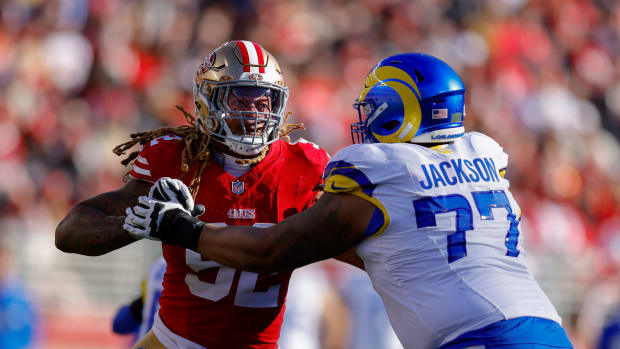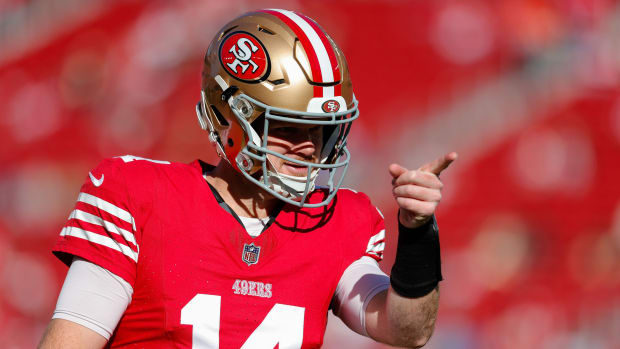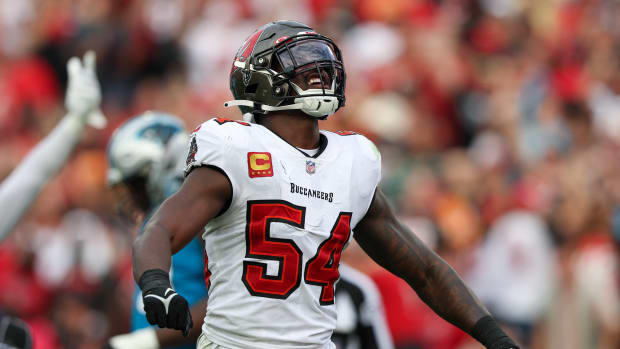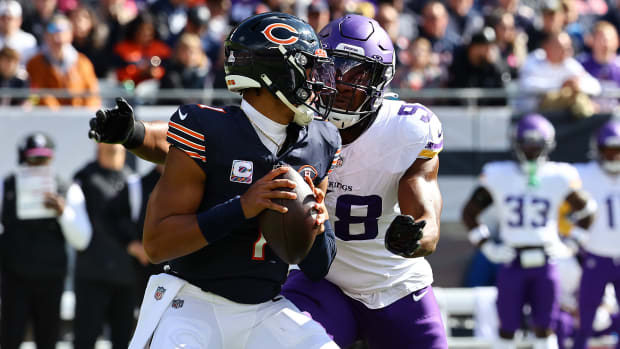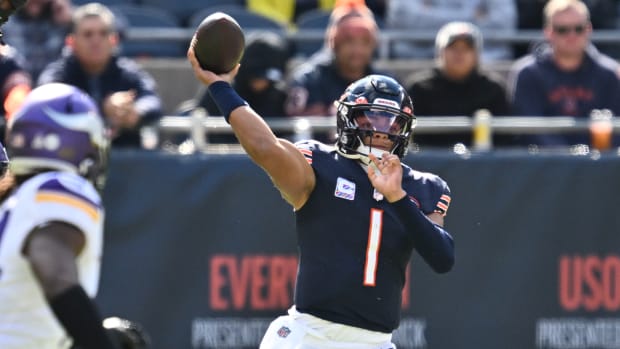Scouting Atlanta: A Dearth of Versatility and Talent on D
1.Matt Ryan’s deft footwork, underrated mobility and sufficient passing tools—mixed with sharp field-reading abilities,—make for a legitimate star quarterback. But he needs to be much more consistent. For a ninth-year quarterback with such attributes, he too often either tries to do too much or just goes plain braindead. Last season this led to costly turnovers, including seven inside the 20-yard lines (second most in the NFL behind Eli Manning). In order for the Falcons to fulfill their potential, their star quarterback must tighten the screws on his decision-making.
• FALCONS CAMP: Dan Quinn’s Roster Remake
2.DeVonta Freeman is the best pure outside zone runner in football. He amplifies his stop/start quickness and speed with a keen sense for reading angles and setting up blocks. Outside zone runs—where the entire O-line works in unison to pin the defense inside and create a corner to turn—are the backbone of offensive coordinator Kyle Shanahan’s system.
• BEST BUDS: When Falcons Train with SEALs
3.Patrick DiMarco, coming off his first Pro Bowl, is the most valuable fullback in the NFL. He’s a steamroller who gives the Falcons a potent two-back offense. Few teams go two-back anymore because a passing game shrinks considerably if the fullback can’t run routes or catch (which most can’t). DiMarco is not great here, either, but he’s just respectable enough to stay on the field. That’s crucial because a big part of Atlanta’s downfield passing game hinges on play-action out of two-back sets. This is especially true when the Falcons are in condensed formations, with the receivers aligned inside the field numbers instead of out wide. When you condense like this, the defense thinks run first and becomes predictable, which sets the table for deep shots.
4. No receiver except for maybe DeAndre Hopkins in Houston saw as many double-teams as Julio Jones last year. Like Hopkins, Jones was the only viable threat in his receiving corps. Roddy White, 34, couldn’t run anymore and Leonard Hankerson dropped too many balls. Both are gone now. In their stead is ex-Bengal Mohamed Sanu and, most likely, last year’s fourth-rounder Justin Hardy. Which means Jones can expect to see just as many doubles as before. Sanu is an upgrade over White and Hankerson, but he’s not a No. 2. The Bengals let him walk because they didn’t believe he could be effective playing more than 30-40 snaps a game. We’ll see.
5. Third-year pro Jake Matthews has a chance to blossom into an upper-tier left tackle, but he needs to develop a stronger anchor against bull-rushers. If he does, the Falcons will have sturdy bookends in him and much-improved right tackle Ryan Schraeder.
6. Nickel situations could be problematic for Dan Quinn’s defense, which is modeled schematically off of Seattle. Any issues in nickel are major given that most offenses today play three receivers more than 60% of the time. Atlanta’s problems in nickel: 1) A paucity of quality pass rushers, including on the edge, where last year’s first-rounder Vic Beasley has looked explosive but much too raw; 2) Questions at linebacker, including: Can Philip Wheeler and second-round rookie Deion Jones cover? If the answer is no, then Atlanta will have problems in the middle of the field on passing downs; 3) Who plays the slot? Robert Alford filled this job in the second half of last season, with rookie Jalen Collins being the outside nickelback. Those are not bad choices, but they’re also not really choices at all considering Atlanta’s cornerbacking depth is nonexistent. (And Collins, remember, is suspended through Week 4.)
7. You’ll see the Falcons’ D substitute different personnel packages a lot this season, just like we saw last season. When done properly, that’s a great way to camouflage a dearth of versatility and talent.
8. Free-agent pickup Courtney Upshaw could be the sounder solution as the Sam ’backer in the base 4-3 than Vic Beasley, who is moving into that role. Quinn’s scheme along the D-line features under fronts, with the three-technique (i.e. gap-shooting defensive tackle) aligned on the weak side, opposite the tight end. For this, you need a linebacker up on the line of scrimmage who, in run defense, can set the edge against tight ends and, in pass defense, jam those tight ends off the line. Upshaw did that nicely in Baltimore.
9. Another critical position in Quinn’s Seahawks-style scheme is strong safety. That player must be able to read route combinations along the hash marks and seams while still honoring his run-fit responsibilities. That’s a lot of north/south ground to account for, and it takes a smart, smashmouth hitter to do it right. In Seattle, Quinn had Kam Chancellor. Hoping to find another presence like that, the Falcons this year spent their first-round pick on Keanu Neal.
10.Desmond Trufant is the most underappreciated cornerback in football. There were several games last season where opponents did not even challenge him. Quinn often asks his outside corners to play solo man coverage (especially if it’s on the same side of the field where the ball is spotted). Trufant is a stopper here.
Question? Comment? Let us know at talkback@themmqb.com
































